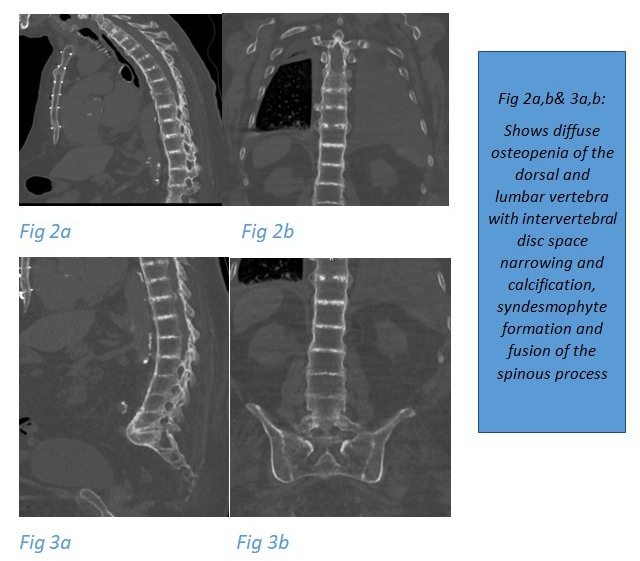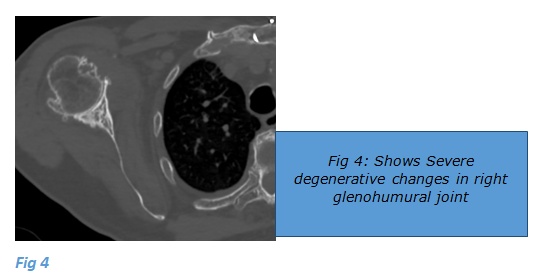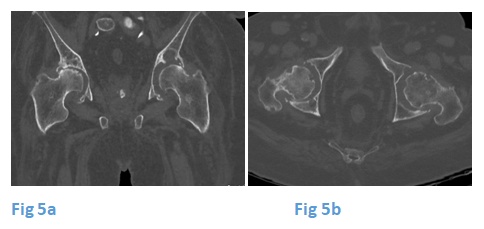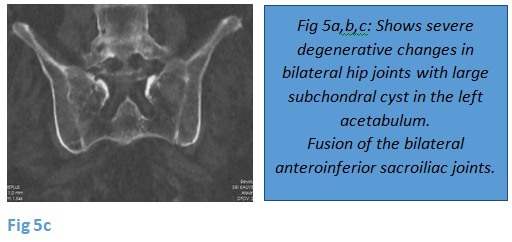Presentation:
Elderly male patient came with non-specific C/o lower abdominal pain and left sided chest pain radiating to back.
Past History:
H/o CABG done on 2006. Known case of Alkaptonuria
ECHO done on 10.12.2022: revealed calcified aortic valve; Severe aortic stenosis
X-ray LS spine and pelvis revealed:
Diffuse osteopenia, disc space narrowing, multilevel intervertebral disc calcification and syndesmophyte formation (fig 1a, b).
Subchondral sclerosis, asymmetrical joint space narrowing at bilateral hip joints. Fusion of bilateral sacroiliac joint spaces (fig 1c).


CT Chest and Abdomen revealed:
Diffuse osteopenia of the dorsal and lumbar vertebra with intervertebral disc space narrowing and calcification, syndesmophyte formation and fusion of the spinous process (fig 2a, b) & (fig 3a, b).
Severe degenerative changes in bilateral glenohumural joints (Fig 4).


Severe degenerative changes in bilateral hip joints with large subchondral cyst in the left acetabulum.
Fusion of the bilateral anteroinferior sacroiliac joints.
(Fig 5a, b, c)


Case Discussion:
Ochronosis is a rare genetic disorder that results in the accumulation of homogentisic acid in the body. This build-up leads to the characteristic darkening and thickening of connective tissue, which can affect various organs and systems in the body. Ochronosis is most commonly seen in individuals with the rare genetic disorder known as alkaptonuria, but it can also occur as a result of long-term exposure to certain medications, such as phenol derivatives.
In the radiology setting, ochronosis can present with various imaging findings depending on the organ systems involved. In the musculoskeletal system, ochronosis can cause severe osteoporosis, multilevel intervertebral disc calcification, disc space narrowing, syndesmophyte formation, symmetrical or asymmetrical joint space narrowing, subchondral sclerosis, ossification and calcification of tendons and ligaments, leading to joint stiffness and pain. These changes may be visible on plain radiographs as well as on MRI or CT.
In the cardiovascular system, ochronosis can lead to the formation of calcified plaques in the aorta and coronary arteries, increasing the risk of cardiovascular disease. These plaques may be visible on non-invasive imaging modalities such as CT angiography or MR angiography.
Ochronosis can also affect the skin and mucous membranes, leading to hyperpigmentation and thickening. These changes may be visible on physical examination, as well as on high-resolution imaging modalities such as dermoscopy or confocal laser endomicroscopy.
The diagnosis of ochronosis is typically made based on a combination of clinical presentation, laboratory findings, and imaging findings. Treatment is typically focused on managing the underlying cause of the condition and addressing any associated complications. In cases of alkaptonuria, enzyme replacement therapy may be recommended. In cases of ochronosis causing arthritis, joint replacement is the treatment of choice.
In conclusion, ochronosis is a rare genetic disorder that can affect various organ systems and present with a variety of imaging findings. Early diagnosis and management are important in minimizing the risk of complications and improving patient outcomes.






